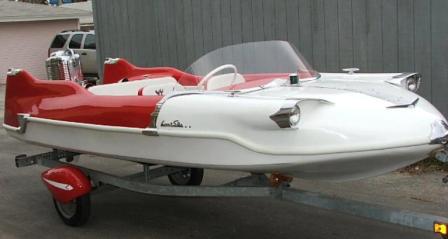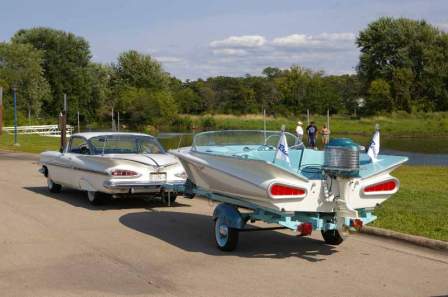

| site search byfreefind | |||
|
|||
the first finned boat was the Meteor, developed by Robert Hammond when he was working for Lone Star, a boat builder in Grand Prairie, Tex. “I was always kind of a car nut when I was younger,” Mr. Hammond, who is 80, said in a telephone interview from his home on Lake Austin, Tex. Having seen the Motorama cars, Mr. Hammond said he wondered how futuristic fins and other car-styling touches would look on a boat. This was in 1956, he recalled, before large fins became common on cars.
Mr. Hammond said his design “in retrospect was kind of ugly,” but Lone Star put the Meteor into production.
Before long, Mr. Hammond left Lone Star and started the Glastron boat company. Production started with the Glastron Fireflite and Surfflite.
While the 1956 Lone Star Meteor was perhaps the first of the finned ’50s boats, the craze really took off in 1958, Mr. Mueller said: “Everybody and his brother was making crazy things, though only a few of each.”
Fiberglass made it easy to get into the boatmaking business, Mr. Mueller said, but many of the builders didn’t realize how labor-intensive the business was. Failures were common.
“There were very few of any individual boat, but there were very, very, very many people who each made a very few, so you had tremendous variety,” Mr. Mueller said.
Another collector who has written extensively about finned fiberglass boats, Lee Wangstad of Nisswa, Minn., estimates that there were perhaps 1,000 manufacturers in the United States and Canada. Many simply “pulled a mold off an existing boat,” made some modifications, and produced perhaps two or three copies, he said. Mr. Wangstad says no one knows just how many boats were produced or how many survive. “So many are hidden behind bushes, in garages, behind buildings,” he said. “I pulled one off the bottom of the lake I live on. I saw it when I was out fishing. It was in eight feet of water.”
Many of the boats survive because, unlike wooden vessels that deteriorate if not maintained, fiberglass has staying power. “Fiberglass doesn’t go away,” Mr. Mueller said. While the top protective layer called the gelcoat “gets terrible,” he said, “the fiberglass stays in good shape.”
“If the boat sinks into the mud and goes through freeze and thaw, it will deteriorate the bottom, but you can fix that. Wooden boats can rot until you can’t use them except as a pattern.”
Fiberglass boats are also easier to maintain after they have been restored, he said. “As long as I keep it drained, I can leave a fiberglass boat sitting out for 20 years before I restore it. Then once you restore it, it stays restored.”
Some boats rescued by collectors have still not been identified, Mr. Mueller said, adding that another Illinois collector found a boat that looks like a cross between a snail and Santa Claus’s sleigh. “It’s the only one we know of in the entire world,” he said, “but we don’t even know what it is.”
A visit to Mr. Mueller’s Web site, www.boatsinthebelfry.com, gives a sense of the variety of boat styles of the period, as does www.bigfinboats.com, a site operated by another enthusiast, David Moehrke.
Courtesy:
http://www.nytimes.com/2009/08/16/automobiles/collectibles/16finboat.html?pagewanted=all&_r=0
Other similar boats:
- Reinell Jet Flight



